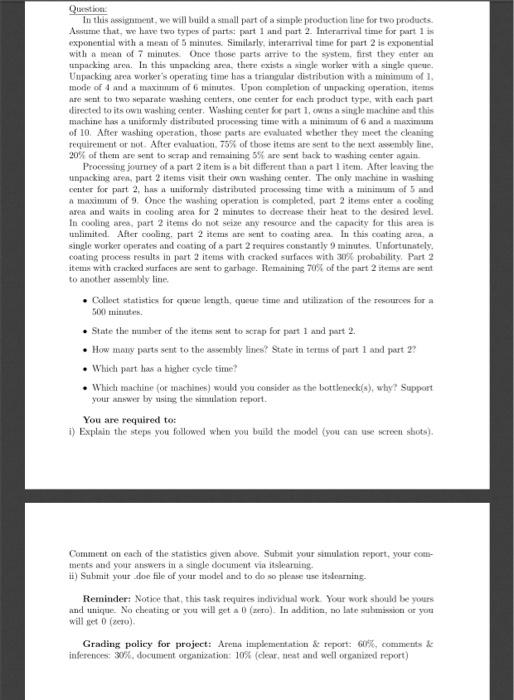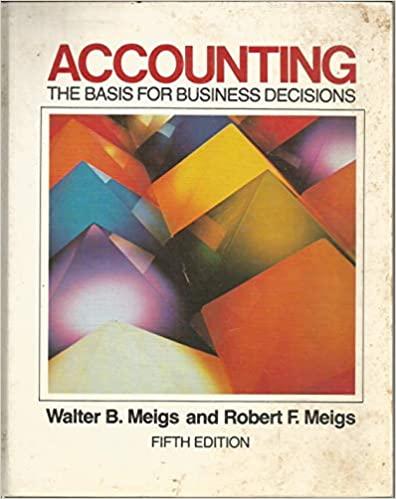Question In this assignment, we will build a small part of a simple production line for two products, Astume that we have two types of parts: part 1 and past 2. Interarrival time for part 1 exponential with a man of 5 minutes. Similarly, interarrival time for part 2 is exponential with a mean of 7 minutes. Once these parts arrive to the system, first they enter an unpacking aron. In this unpacking area, there exists a single worker with a single queue Unpacking area worloer's operating time has a triangular distribution with a minimum of 1 mode of 4 and a maximum of 6 minutes. Upon completion of unpacking operation, items are sent to two separate washing centers, one center for each product type, with each part directed to its own washing center, Washing center for part 1, ws a single machine at this machine has a uniformly distributed processing time with a minimum of 6 and a maximum of 10. After washing operation, those parts are evaluated bether they meet the cleaning requirement or not. After evaluation, 75% of those items are sent to the next assembly line, 20% of them are sent to scrap and remaining 5% are sent back to washing center again Processing mey of a part 2 item is a bit different than a part 1 item. After leaving the unpacking area, part 2 items visit their own washing center. The only machine in washing center for part 2, has a uniformly distributed processing time with a minimum of 5 and a maximum of 9. Once the washing operation is completed, part 2 items enter a cooking area and waits in cooling area for 2 ministes to decrease their heat to the desired level In cooling area, part 2 items do not see any resource and the capacity for this area is unlimited. After cooling, part 2 items are sent to conting area. In this coating area, a single workour operates and counting of a part 2 requires constantly 9 minutes. Unfortunately, coating process results in part 2 items with cracked surfaces with 30% probability Part 2 item with crncloed warfaces are set to garbage. Remaining 70% of the part 2 items are sent to another assembly line . Colloct statistics for quxue length, quantae time and utilization of the resources for a 500 minutes State the mumber of the items went to scrap for part 1 and part 2 How many parts sent to the assembly lines? State in terras of part 1 and part 2 Which part has a higher cycle time? Which machine (or machines) would you consider as the bottlenecks), why? Support yout anwes by wing the situation report. You are required to: i) Explain the steps you followed when you build the model (you can use screenshots). Comment on each of the statistics given above. Submit your simulation report, your com ments and your ansvers in a single document via itslearning ii) Submit your doe file of your model and to do so please atsdeurning, Reminder: Notice that this task requires individual work. Your work should be yours and mique. No cheating of yott will get a 0 (zero). In addition, too late subunitions or you will get 0 (zero) Grading policy for project: Art implementation & report: 60%, comments inferences: 30%, document organization: 10% (clear test and well organized report) Question In this assignment, we will build a small part of a simple production line for two products, Astume that we have two types of parts: part 1 and past 2. Interarrival time for part 1 exponential with a man of 5 minutes. Similarly, interarrival time for part 2 is exponential with a mean of 7 minutes. Once these parts arrive to the system, first they enter an unpacking aron. In this unpacking area, there exists a single worker with a single queue Unpacking area worloer's operating time has a triangular distribution with a minimum of 1 mode of 4 and a maximum of 6 minutes. Upon completion of unpacking operation, items are sent to two separate washing centers, one center for each product type, with each part directed to its own washing center, Washing center for part 1, ws a single machine at this machine has a uniformly distributed processing time with a minimum of 6 and a maximum of 10. After washing operation, those parts are evaluated bether they meet the cleaning requirement or not. After evaluation, 75% of those items are sent to the next assembly line, 20% of them are sent to scrap and remaining 5% are sent back to washing center again Processing mey of a part 2 item is a bit different than a part 1 item. After leaving the unpacking area, part 2 items visit their own washing center. The only machine in washing center for part 2, has a uniformly distributed processing time with a minimum of 5 and a maximum of 9. Once the washing operation is completed, part 2 items enter a cooking area and waits in cooling area for 2 ministes to decrease their heat to the desired level In cooling area, part 2 items do not see any resource and the capacity for this area is unlimited. After cooling, part 2 items are sent to conting area. In this coating area, a single workour operates and counting of a part 2 requires constantly 9 minutes. Unfortunately, coating process results in part 2 items with cracked surfaces with 30% probability Part 2 item with crncloed warfaces are set to garbage. Remaining 70% of the part 2 items are sent to another assembly line . Colloct statistics for quxue length, quantae time and utilization of the resources for a 500 minutes State the mumber of the items went to scrap for part 1 and part 2 How many parts sent to the assembly lines? State in terras of part 1 and part 2 Which part has a higher cycle time? Which machine (or machines) would you consider as the bottlenecks), why? Support yout anwes by wing the situation report. You are required to: i) Explain the steps you followed when you build the model (you can use screenshots). Comment on each of the statistics given above. Submit your simulation report, your com ments and your ansvers in a single document via itslearning ii) Submit your doe file of your model and to do so please atsdeurning, Reminder: Notice that this task requires individual work. Your work should be yours and mique. No cheating of yott will get a 0 (zero). In addition, too late subunitions or you will get 0 (zero) Grading policy for project: Art implementation & report: 60%, comments inferences: 30%, document organization: 10% (clear test and well organized report)







